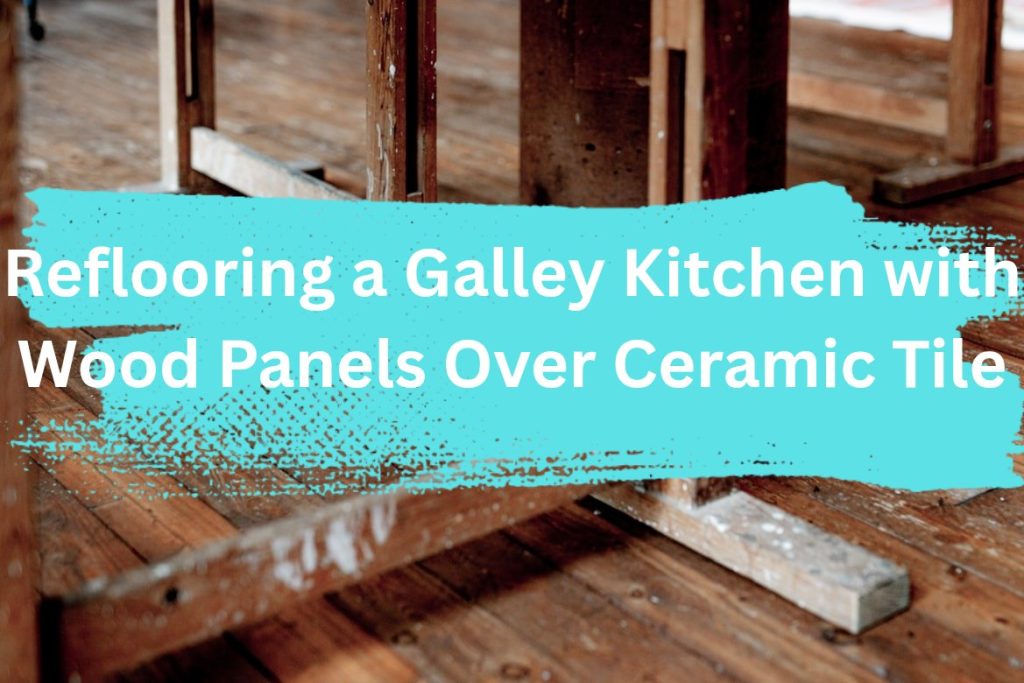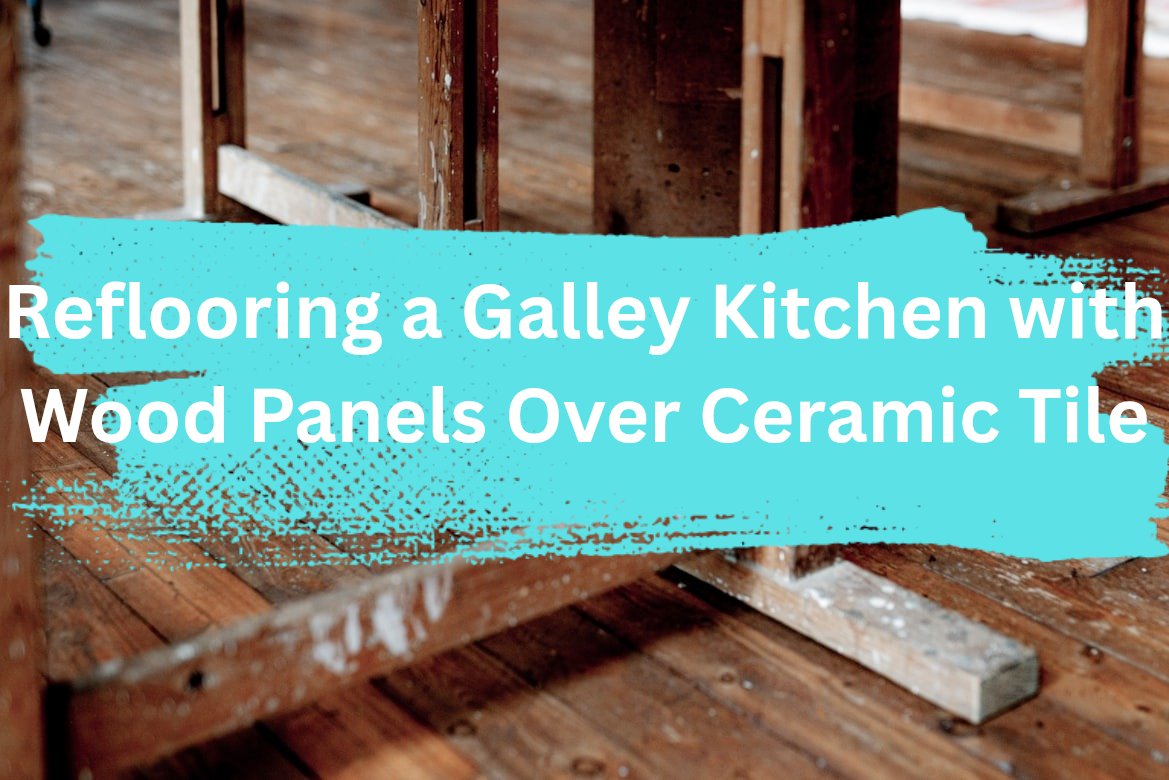Ever stood in your galley kitchen and thought, “This tile has seen better days”? I’ve been there, staring at ceramic flooring that looks worn, cold, and just plain outdated.
Solution? Reflooring a galley kitchen with wood panels over ceramic tile. It’s faster, cheaper, and way less messy than a full demolition.
Can You Really Install Wood Over Ceramic Tile?
Yes, you can. Wood flooring — whether it’s engineered hardwood, laminate, or luxury vinyl planks that mimic wood, can go directly over ceramic tile. The key is prepping the surface properly so you don’t end up with uneven floors.

Items You’ll Need for Reflooring
- Measuring tape and chalk line
- Tile patch or replacement tiles (if needed)
- Heavy-duty cleaner and degreaser
- Self-leveling compound and trowel
- Foam or cork underlayment rolls
- Wood panels (engineered hardwood, laminate, or vinyl planks)
- Spacers, tapping block, and pull bar kit
- Jigsaw or circular saw
- Transition strips and baseboards
- Hammer and finishing nails (or nail gun)
- Safety gear: gloves, goggles, knee pads
Steps to Refloor a Galley Kitchen with Wood Panels
- Inspect Your Tile
Make sure your ceramic is solid. Tap around — if tiles sound hollow or cracked, replace or patch them first. - Clean Thoroughly
Degrease and vacuum the floor. Kitchens collect grease near stoves, so a strong cleaner is a must. - Level the Surface
Use a self-leveling compound to fill grout lines and low spots. This ensures your wood panels sit flat. - Install an Underlayment
A thin foam or cork underlayment smooths out imperfections and adds sound absorption. Some wood panels come with underlayment pre-attached.
Amazon tip: Look at options like quiet walk underlayment rolls or cork sheets — affordable and DIY-friendly. - Lay the Wood Panels
Start along the longest wall of your galley kitchen. Click-lock systems make it simple: align, snap, and keep moving. - Trim and Finish
Use a jigsaw to cut around cabinets, appliances, or that pesky vent pipe (speaking of which, check my guide on how to hide kitchen vent pipe for neat tricks around visible pipes). Add baseboards or quarter round for a polished finish.
After you’ve set the last panel, give the adhesive or locking system time to settle. Depending on the product, curing may take a couple of days before the kitchen is back to full use. Once cured, consider adding trim or molding around the edges for a neat, finished appearance. You can even paint or stain the wood to boost both looks and durability.
A smart extra step is laying down rugs or mats in high-traffic spots — near the sink or stove — to reduce wear and tear. With thoughtful finishing touches, your galley kitchen floor won’t just look refreshed, it’ll feel cozy, stylish, and practical for years to come.
Choosing the Right Wood Look for a Galley Kitchen
Galley kitchens are narrow, so the direction and color of your panels matter.
- Run planks lengthwise to elongate the kitchen visually.
- Lighter tones (like ash or maple) make the space feel airy and open.
- Darker woods add drama but can make the space look tighter.
I recommend a stainless steel kitchen utensil set (I’ve written about those before) to complement the wood and tie the whole look together with modern accents.
Why It Works:
- Ceramic is stable and strong, so it provides a good base.
- Modern floating wood panels are designed with locking systems that make them ideal for going over existing floors.
- You save time and avoid the headache (and dust!) of removing tile.
Extra Value Tips Most People Miss
- Moisture Matters: Kitchens are spill zones. Go for water-resistant laminate or vinyl panels if you’re a frequent cook.
- Transitions Count: If your galley kitchen opens into another room, grab a matching transition strip for a clean flow.
- DIY Tool Must-Haves: Spacers, tapping block, and pull bar kits make installation much easier. You’ll find solid starter kits on Amazon.
- Future Access: If you have floor vents or a plumbing cleanout, make sure cuts are neat and removable.
When to Call a Pro
If your ceramic is severely uneven or if your kitchen has water damage, it may be smarter to call in a flooring contractor. They’ll know when tile removal is unavoidable.
Conclusion
Reflooring a galley kitchen with wood panels over ceramic isn’t just possible — it’s one of the best bang-for-buck upgrades you can do. It warms up the space, covers dated tile, and makes your kitchen feel fresh without the chaos of demolition.
Grab some quality panels, prep the floor properly, and you’ll be amazed how quickly your galley transforms.
For more kitchen fixes, check out my guide on how to remove kitchen soffit — it pairs perfectly with a flooring update if you’re aiming for a sleek, modern look.
FAQs
Can I put wood flooring over uneven ceramic tile?
Only if you level it first. Use self-leveling compound to smooth grout lines and low spots.
What type of wood panels are best for kitchens?
Engineered hardwood and luxury vinyl planks are both durable and water-resistant. Laminate works too, but avoid it if your kitchen gets lots of spills.
Do I need to remove cabinets first?
No. Install the panels right up to the cabinet bases, leaving a small expansion gap.
How long does it take to install wood over tile in a galley kitchen?
Most DIYers can finish in a weekend, depending on prep work.
Will wood over tile raise my floor height too much?
Not usually. Most panels add only 3/8” to 1/2” thickness, which transition strips handle easily.
